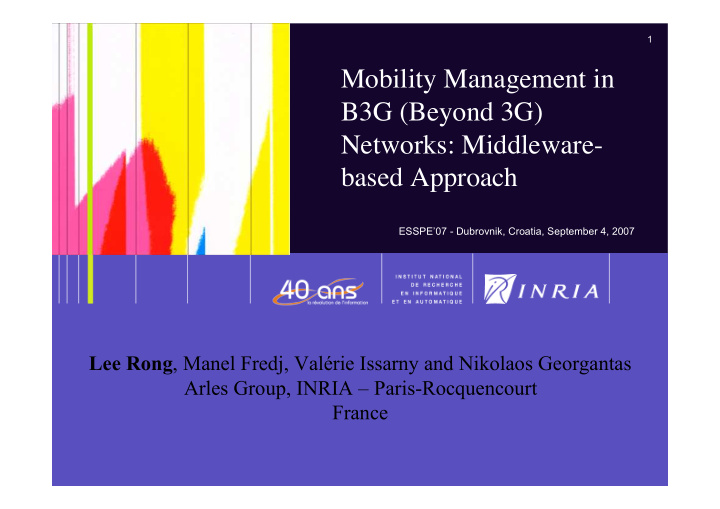



1 Mobility Management in B3G (Beyond 3G) Networks: Middleware- based Approach ESSPE’07 - Dubrovnik, Croatia, September 4, 2007 Lee Rong , Manel Fredj, Valérie Issarny and Nikolaos Georgantas Arles Group, INRIA – Paris-Rocquencourt France
2 Overview • Introduction • Related work on mobility management in B3G • Use case scenario • Requirements for mobility management in B3G • Propose a mobility management middleware solution • Conclusion
3 Introduction The B3G (Beyond 3G) network concept: • Future network environment: heterogeneous network, all-IP platform • Infrastructure based or infrastructure-less • User device equipped with multi-radio interfaces • Goal: enable mobile users to roam freely mobility management Service Layer BT B3G WLAN UMTS LAN WiMAX GPRS
4 Background on mobility management Telecomm based: • Horizontal and vertical handoffs • Many approaches: Session Initiation Protocol (SIP) - application layer , Mobile IPv4 and Mobile IPv6 - network layer , Stream Control Transmission Protocol (SCTP) - transport layer • Rely on central entities or tied to a specific OSI layer Service oriented: • Find a service substitute and perform reconfiguration (i.e., Gaia) • Centralized approaches, B3G is not considered
5 Use case scenario WLAN Access Point Dr. Franklin WLAN Access Point Dr. Smith Home Mike & 3G George Station
Requirements for mobility management in 6 B3G: core types Provide mobility through network handoffs : • e.g., WiFi to GPRS • devices communicate in an ad hoc manner, handoff not rely on any central entities, manage multi-radio connections Provide mobility through service reconfiguration : • e.g., transfer diagnose duty from Dr. Smith to Dr. Franklin • mobile service providers, difficult to sustain connections, service inaccessible on other networks
Requirements for mobility management in 7 B3G: specific types Provide specific mobility management for streaming applications : • e.g., teleconferencing between the doctors and George • multi-modality support (e.g., switch from video to audio), buffer support Provides specific mobility support by delivering messages and data to users • e.g., message exchange between Dr. Franklin and George • asynchronous delivery
8 Propose a mobility management solution PLASTIC middleware: initial architecture PLASTIC: IST-6 project aims at supporting SOA based B3G communication Allows Enables SOAP Uses PLASTIC@ collection, Enables Senses to indentify a based storage and context-aware networks, device, associates interaction in retrieval of service access retrieves status, with multiple B3G B3G context and discovery controls radio connections, advanced interfaces networking
Propose a mobility management solution 9 cont… Aims to provide a set of PLASTIC middleware simple and uniform with mobility management module APIs: transparent and explicit Multi-homing • Fully distributed, Service Substitute: Mobility Mng : uses Application specific do not require any reactively or PLASTIC@ to mobility proactively searches support vertical central entities, management: for substitutes handoff, • OSI layer streaming and Session State Eng: Horizontal Handoff asynchronous independent adapts and transfers Mng : manages message delivery session states horizontal handoffs
10 Conclusion Proposed an mobility management middleware extension: • Handle mobility in B3G networks : fully distributed, OSI layer independent • Four different handling mechanisms are considered: two core types and two specific types • Provide a set of simple and uniform APIs • Currently under development: network handoffs and service reconfiguration • Future research direction: performance evaluation, comparison to IMS, investigate application specific mobility
11 Thank You and questions Questions relate to the presentation: • What other mobility management aspects should also be considered within the B3G context? Open questions: • Is distributed B3G feasible in eHealth, especially with emergency situations? • Rely on a distributed B3G (privacy, trust)?
Recommend
More recommend